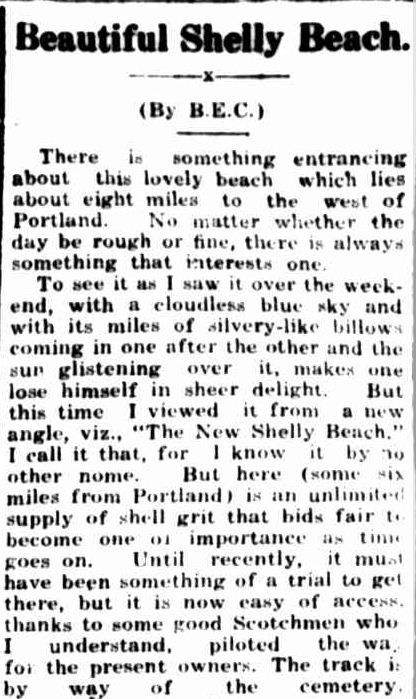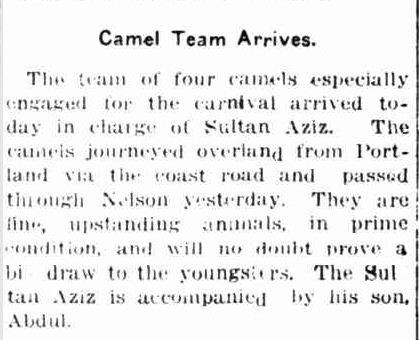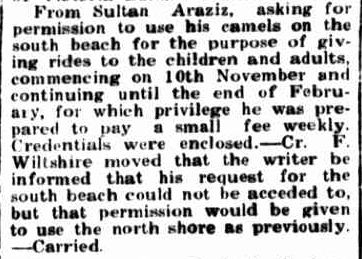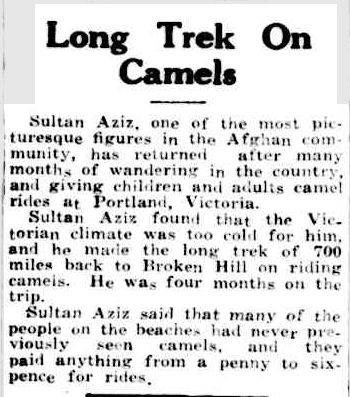This was going to be a post about our visit to Shelly Beach in January, a trip to rekindle childhood memories of visits there. Along with photos and an article which described the beauty of the beach, I had it covered. However, as is usually the case, I could not settle at that. I had to search Trove for more information on Shelly Beach and what I found has given the post a twist as I introduce you to a wonderful character who had a link to Shelly Beach in the 1930s.
Firstly, here is part of the article “Beautiful Shelly Beach” that was going to feature.

Beautiful Shelly Beach. (1939, March 30). Portland Guardian (Vic. : 1876 – 1953), p. 3 Edition: EVENING.. Retrieved March 26, 2012, from http://nla.gov.au/nla.news-article64392283
When I returned to Trove, I was keen to find a photo of Shelly Beach. What I found was beyond my expectations.

No title. (1933, June 24). The Argus (Melbourne, Vic. : 1848 – 1956), p. 5. Retrieved March 26, 2012, from http://nla.gov.au/nla.news-article4744401
The caption reads: “These camels are employed in removing grit from Shelly Beach, near Portland. Each carries two bags each weighing 2cwt. each and makes 15 trips daily over the sandhills. The owner is over 70 years old and has four wives”.
Well, I couldn’t leave it there. Back to the Portland Guardian, I went to search “camels Shelly Beach”. From that, I discovered a lot more about the mysterious man with the camels. Jumping ahead two years from the original picture I found the following “Letter to the Editor” from the man himself:

Camels at Portland. (1935, January 24). Portland Guardian (Vic. : 1876 – 1953), p. 1 Edition: EVENING.. Retrieved March 26, 2012, from http://nla.gov.au/nla.news-article64287962
From one letter, so much is learnt. Sultan Aziz, it seems, was giving rides to tourists on the North beach at Portland during the summer and carting shell grit at Shelly Beach during the winter. He was working for Mr Vivian Jennings, a local carrier. Why were the camels being used to cart the shell grit? The next article explains:

CARTING SHELL GRIT. (1933, May 16). The Horsham Times (Vic. : 1882 – 1954), p. 5. Retrieved March 26, 2012, from http://nla.gov.au/nla.news-article72660392
Sultan Aziz appears to have been in Portland from at least 1933, but he did travel around the south-west and into South Australia. In 1934, he and his camels were the star attraction of the Mt. Gambier Tourist Promotion Association parade on 21 February 1934. Sultan Aziz arrived the day before after travelling along the coast from Portland.

T.P.A. CARNIVAL. (1934, February 20). Border Watch (Mount Gambier, SA : 1861 – 1954), p. 1. Retrieved March 26, 2012, from http://nla.gov.au/nla.news-article77960150
From this, we now know that the Sultan had a son, Abdul.
Mt. Gambier embraced Aziz, if the front page of the Border Watch on 22 February 1934, was any indication. My favourite photo was that of the mayor, dressed in cameleers robes, riding one of Sultan Aziz’s camels.

MAYOR LEADS CARNIVAL PROCESSION ASTRIDE CAMEL. (1934, February 22). Border Watch (Mount Gambier, SA : 1861 – 1954), p. 1. Retrieved March 26, 2012, from http://nla.gov.au/nla.news-article77960232
There were five photos on the front page that day, all of which included the camels! Sultan Aziz spent at least a month in South Australia selling camel rides at the Mt. Gambier Showgrounds. It was not a profitable exercise as discussed at a meeting of the Mt. Gambier A & H Society in March 1934.

MOUNT GAMBIER A. & H. SOCIETY. (1934, March 3). Border Watch (Mount Gambier, SA : 1861 – 1954), p. 3. Retrieved March 26, 2012, from http://nla.gov.au/nla.news-article77960562
On his way back to Portland, Aziz called in at Allendale East, south of Mt. Gambier. The camels were once again a source of excitement.

REPORTS FROM RURAL CENTRES. (1934, March 20). The Advertiser (Adelaide, SA : 1931 – 1954), p. 19. Retrieved March 26, 2012, from http://nla.gov.au/nla.news-article47544800
In October 1934, the Sultan applied to the Portland Council to have his camels on the South Beach over the summer, however, the council decided he should stay on the North Beach.

Borough Council. (1934, October 4). Portland Guardian (Vic. : 1876 – 1953), p. 3 Edition: EVENING.. Retrieved March 27, 2012, from http://nla.gov.au/nla.news-article64286951
The following photo was taken during summer 1935 at Portland. The former Portland Baths are in the background. Enjoying the novelty of a camel ride are Eileen Hickmer, Gladys Read and Jean Ainsworth.

SULTAN AZIZ’S CAMELS ON PORTLAND BEACH IN 1935. Image courtesy of the Museums Victoria Collections https://collections.museumvictoria.com.au/items/773643
This takes us to the time of the “Letter to the Editor” of January 1935. The Sultan only stayed in Portland another six months, leaving just as another southern winter hit. He returned home to Broken Hill. It may well have been a combination of cold weather and the discontent over his camels he spoke of in his letter. His trip to Portland made news in Broken Hill’s Barrier Miner.

Long Trek On Camels. (1935, October 5). Barrier Miner (Broken Hill, NSW : 1888 – 1954), p. 7 Edition: SPORTS EDITION. Retrieved March 27, 2012, from http://nla.gov.au/nla.news-article46707350
An interesting part of this story is Sultan Aziz’s age. The photo I found from 1933, gives his age as over 70. Eight years later in 1941, he was claiming he was 112 which would have made him 104 when the photo on Shelly Beach was taken! I don’t know about that.

“God Is Good” Says Sultan Aziz. (1941, May 16). Barrier Miner (Broken Hill, NSW : 1888 – 1954), p. 1 Edition: HOME EDITION. Retrieved March 27, 2012, from http://nla.gov.au/nla.news-article48407504
A year later he was back in the news, claiming he, at 113 was the oldest person in the Commonwealth.

SULTAN AZIZ CLAIMS TO BE OLDEST MAN IN THE COMMONWEALTH; 113 YEARS AND IS STILL GOING STRONG. (1942, August 13). Barrier Miner (Broken Hill, NSW : 1888 – 1954), p. 3. Retrieved March 27, 2012, from http://nla.gov.au/nla.news-article48401748
Sadly, age did catch up with Sultan Aziz. He passed away in 1950. His age was given as 105.

AFGHAN DIES AT 105. (1950, August 16). Barrier Miner (Broken Hill, NSW : 1888 – 1954), p. 12. Retrieved March 27, 2012, from http://nla.gov.au/nla.news-article49578554
Summarising Sultan Aziz’s life in Australia through the newspaper articles, I found he was born in Afghanistan and arrived in Albany, Western Australia via India, around 1885. His memories from that time included organising a camel race for His Royal Highness, The Duke of York and Cornwall who would, in 1910, become King George V.
An article from the Northern Times, Carnarvon, Western Australia on March 23, 1912, saw Aziz still in W.A. However, he was selling his camels and then sailing for South Australia to take camels back overland to Carnarvon. I don’t think he made it all the way back as he ends up in Broken Hill with a carting contract around that time. Many other cameleers from Afghanistan were camped at Broken Hill. He carted goods into central Australia with his camels, working for Sir Sidney Kidman. At one time he claims to have owned up to 200 camels. In the 65 years he was in Australia, he must have racked up some miles on his camels. The trip from Broken Hill to Portland alone was over 900 kilometres.
He had a least one son, Abdul Aziz, who accompanied his father on his trip to Victoria. Abdul attended school while in Portland and went on to serve in WW2.
In his later years, Sultan Aziz was the caretaker of the mosque in Broken Hill and tended his fowls.
Of course, this is mostly information provided by Sultan Aziz himself and is still to be supported by other sources.
I also did a search for marriages for Sultan Aziz, because I had to know if he did have up to four wives. However, I did not find a harem, rather a marriage in 1923 to Bigham Kahn at Broken Hill. This could be Abdul Aziz’s mother. It is possible that Sultan Aziz had wives he left in Afganistan, which was not unusual for the cameleers.
It really is a great story of another colourful character to find his way into the Western District of Victoria. I wonder if any of my relatives saw their first camel or paid a penny for a ride on the North Portland Beach.
Further Reading:
If you would like to learn more about the cameleers who helped explorers and pastoralists venture into inland Australia, the website Australia’s Muslim Cameleers is worth a visit. There is so much information about the Muslim cameleers, including biographies. Yes, Sultan Aziz’s biography is among them. One interesting fact is that at least 2000 cameleers arrived in Australia during the fifty years from 1870 to 1920 and 20,000 camels! Most Australians would know Central Australia today has a lot of camels but would have no idea how and why they are there.
There is also a book by Phillip Jones and Anna Kenny, Australia’s Muslim Cameleers. It includes a biographical listing of over 1200 cameleers.
The Age, on January 3, 2012, published an article entitled Afghans, cameleers and the massacre of Broken Hill. It includes photos of cameleers and a mining registration form belonging to Sultan Aziz. This was from 1939 and according to his own calculations at the time, he would have been around 110! There is a photo, so see what you think.
I also located the WW2 service record of Abdul Aziz. This was sad to read. Abdul, born in 1923, enlisted in the Australian Military Service in 1942, aged 18 and later the A.I.F. in 1944. He was sent to Bougainville in 1945 and after only four months, he received life-threatening wounds to his leg, thanks to a shell. He returned to Australia.
Further on in the service record, I found a letter from 1958 of Thora Aziz’s application to buy a home with help from Legacy. Her husband Abdul had died in 1951. He would have been only 28. Such a short life for the son of a centenarian.



great story Merron, what an interesting character!
LikeLike
Thanks Kerryn. He’s great isn’t he?
LikeLike
thank u for this great history regarding my grandfather and father the gentleman i only heard about and never got to know them as god took them away when i was a baby.thank u all .don
LikeLike
Hi Don
Thank you for your lovely comment. You should be very proud of your grandfather and his history.
Merron
LikeLike
Thank you for providing so much information about such an intriguing character and the history of the shell carting from Shelly Beach to Portland. My husband and I took our two children to Cape Bridgewater recently for a few days, and we were all very interested in the history of the camels at Shelly Beach. My daughter is in year 5 at Apollo Bay this year and is writing interesting facts about Australia for homework each week, and she remembered our trip to Cape Bridgewater. She decided to write about the camels at Shelly Beach this week. Absolutely fascinating!
LikeLike
Thank you so much for your lovely comment Samantha. I enjoy writing about characters like Sultan Aziz because it keeps their story alive and after hearing from you makes it all worth while. I hope your daughter’s assignment is a success and it’s great to hear about children developing a passion for history.
LikeLike
Merron,
The article on Shelly Beach by ‘B.E.C.’ from the ‘Guardian’ (30.3.’39) was written by Bert Carthew who was the Post master at Portland for some years before his retirement. He was a keen photographer though not a particularly good one, a bird observer and was one of the foundation members of the Portland Field Naturalists along with Noel Learmonth. The Shelly Beach he describes is not the one at Bridgewater but the one near Murrell’s Beach on the west side of Cape Nelson. It was operated by Theo Jarrett and his partner Fred Redfern during the years of WW II when grit of the required size was railed from Portland. Commercial egg producers fed it to their birds as they required a source of calcium. Sea shells for eggs shells – as it were! The stuff had to be barrowed along planks to be hauled to the top of the cliff on a steeply inclined wooden railway with a winch driven by an old kerosene tractor engine, and it was then bagged. The size of the shell grit varied with the condition of the seas and it was only with the right circumstances that the right type could be obtained, so it was a very seasonal business. After the war the partners surrendered it to a returned soldier, Andrew Murrell, who lived not far from the beach at Cape Nelson. The grit is still there but the demand has almost disappeared.
BJ.
LikeLike
Thank you so much for your clarification BJ. It is an interesting part of the history of the area and another industry to disappear.
LikeLike